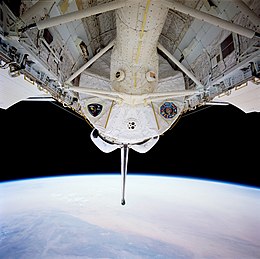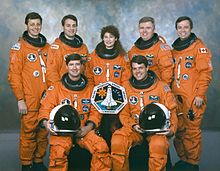STS-78
 Spacelab Module LM2 inColumbia'spayload bay, serving as the Life and Microgravity Spacelab | |
| Mission type | Bioscience research Microgravity research |
|---|---|
| Operator | NASA |
| COSPAR ID | 1996-036A |
| SATCATno. | 23931 |
| Mission duration | 16days, 21hours, 48minutes, 30seconds |
| Distance travelled | 11,000,000 kilometres (6,800,000 mi) |
| Orbits completed | 271 |
| Spacecraft properties | |
| Spacecraft | Space ShuttleColumbia |
| Payload mass | 9,649 kilograms (21,272 lb) |
| Crew | |
| Crew size | 7 |
| Members | |
| Start of mission | |
| Launch date | June 20, 1996, 14:49:00.0075UTC |
| Launch site | KennedyLC-39B |
| End of mission | |
| Landing date | July 7, 1996, 12:37:30UTC |
| Landing site | KennedySLF Runway 33 |
| Orbital parameters | |
| Reference system | Geocentric |
| Regime | Low Earth |
| Perigee altitude | 246 kilometres (153 mi) |
| Apogee altitude | 261 kilometres (162 mi) |
| Inclination | 39.0 degrees |
| Period | 89.6 minutes |

 Left to right – Seated: Henricks, Kregel; Standing: Favier, Linnehan, Helms, Brady, Thirsk | |
STS-78was the fifth dedicated Life and MicrogravitySpacelabmission for theSpace Shuttle program,flown partly in preparation for theInternational Space Stationproject. The mission used theSpace ShuttleColumbia,which lifted off successfully fromKennedy Space Center'sLaunch Pad 39Bon June 20, 1996. This marked the 78th flight of the Space Shuttle and 20th mission forColumbia.
Crew
[edit]| Position | Astronaut | |
|---|---|---|
| Commander | Fourth and last spaceflight | |
| Pilot | Second spaceflight | |
| Mission Specialist 1 | First spaceflight | |
| Mission Specialist 2 | Third spaceflight | |
| Mission Specialist 3 | Only spaceflight | |
| Payload Specialist 1 | Only spaceflight | |
| Payload Specialist 2 | First spaceflight | |
Backup crew
[edit]| Position | Astronaut | |
|---|---|---|
| Payload Specialist 1 | First spaceflight | |
| Payload Specialist 2 | First spaceflight | |
Mission objectives
[edit]- Research into the effects of long-duration spaceflight on human physiology in preparation for flights on the International Space Station.
- 22 life science and microgravity experiments using the Orbiter's pressurised Life & Microgravity Spacelab module (LM2).
- Tests into the use of the Orbiter'sReaction Control Systemjets to raise the altitude of orbiting satellites.
Mission highlights
[edit]
During the 16-day, 21-hour mission, the crew ofColumbiaassisted in the preparations for the International Space Station by studying the effects of long-duration spaceflight on the human body in readiness for ISS Expeditions, and also carried out experiments similar to those now being carried out on the orbital station.
Following launch,Columbiaclimbed to an altitude of 278 kilometers (173 mi) with an orbital inclination of 39° to theEarth'sequatorto allow the seven-member flight crew to maintain the same sleep rhythms they were accustomed to on Earth and to reduce vibrations and directional forces that could have affected on-board microgravity experiments.
Once in orbit, the crew entered the 40 feet (12 m) long pressurized Spacelab module to commence over 40 science experiments to take place during the mission. Not only did these experiments make use of the module's laboratory, but also employed lockers in the middeck section of the orbiter. Thirteen of the experiments were dedicated to studying the effects of microgravity on the human body, whilst another six studied the behaviour of fluids and metals in the almost weightless environment and the production of metallic alloys and protein crystals. The crew also carried out the first ever comprehensive study of sleep patterns in microgravity, research into bone and muscle loss in space, and in-flight fixes to problem hardware on the Bubble, Drop and Particle Unit (BDPU), designed to study fluid physics.
The mission also featured a test of a procedure that was later used during the secondHubble Space Telescopeservicing mission to raise the telescope's altitude without damaging the satellite's solar arrays. During the test,Columbia'svernier Reaction Control System jets were gently pulsed to boost the Shuttle's altitude without jarring any of the mission payloads. The test was successful, and was later employed byDiscoveryduringSTS-82,and was used multiple times to boost the orbit of the ISS when docked with an orbiter.
Mission anomaly
[edit]Although the launch went without any issue, an issue was discovered with thesolid rocket boosters(SRBs) following their disassembly in June post-recovery. Analysis showed worrying damage to the field joints which was likely caused by hot gases. Failure of booster seals on the lower sections ofSpace ShuttleChallenger's right SRB ultimately caused theorbiter to break up mid-flightin 1986.[1][2]This time the issue did not compromise astronaut safety because the hot gas path traveled through the engines' field joints but not their capture joint (containing the infamous "O-ring" seals). Despite there being no issue with safety, it did raise questions about a newEnvironmental Protection Agency(EPA)–mandated adhesive and cleaning fluid.[3][4]
Due to the issue,STS-79which was meant to dock with theSpace StationMirand return astronautShannon Lucid,was delayed.[4][5]Options of returning Shannon on a Soyuz were considered,[citation needed]but never followed through as the Shuttle was considered safe and able to return Shannon.[citation needed]
See also
[edit]- List of human spaceflights
- List of Space Shuttle missions
- Outline of space science
- STS-80(17 day 8 hour Shuttle mission)
- STS-67(16 days 15 hour Shuttle mission)
- STS-73(15 days 21 hours Shuttle mission)
References
[edit]- ^Helveston, John Paul (Fall 2019)."A case study on turning data into information".EMSE6574: Fall 2019.George Washington University.RetrievedJune 15,2024.
- ^Presidential Commission on the Space Shuttle Challenger Accident(June 6, 1986)."Chapter IV: The Cause of the Accident".Report of the PRESIDENTIAL COMMISSION on the Space Shuttle Challenger Accident.National Aeronautics and Space Administration (NASA)(Report). Washington, D.C.RetrievedJune 15,2024.
- ^"'Man, I'm Here': 20 Years Since the Record-Setting Mission of STS-78 (Part 1) ".AmericaSpace.June 18, 2016.RetrievedJune 15,2024.
- ^ab"NASA DELAYS LAUNCH OF SPACE SHUTTLE".NASA(Press release). July 12, 1996. Archived fromthe originalon February 23, 2010.
- ^"NASA-2 Shannon Lucid: Enduring Qualities".Shuttle-Mir: The U.S. and Russia Share History's Highest Stage (CD-ROM edition).NASA. September 2001.RetrievedJune 15,2024.
External links
[edit]- NASA mission summaryArchivedMay 13, 2021, at theWayback Machine
- STS-78 Video HighlightsArchivedJanuary 21, 2012, at theWayback Machine
![]() This article incorporatespublic domain materialfrom websites or documents of theNational Aeronautics and Space Administration.
This article incorporatespublic domain materialfrom websites or documents of theNational Aeronautics and Space Administration.

